Absolute Value
| Site: | St. Louis |
| Course: | Michigan Algebra I Sept. 2012 |
| Book: | Absolute Value |
| Printed by: | Guest user |
| Date: | Sunday, November 30, 2025, 9:32 AM |
Description
Absolute Value Functions
Introduction
So, the absolute value of a positive number is the number itself, and the absolute value of a negative number is its opposite. The absolute value of zero is 0.
The absolute value bars do not work in the same way as do parentheses. Where -(-3) = +3, this is not true in -|-3|. To simplify -|-3| first simplify the absolute value part. The distance -3 is from zero is 3 units so the absolute value of -3 is 3, so -|-3| = - (+3) = -3.
Solving Equations
To solve, IxI + 2 = 10, use the following steps:
Step 1. Isolate the absolute value bars using inverse operations.
|x| + 2 - 2 = 10 - 2
|x| = 8
Step 2. Write two equations.
b. Write the other equation to equal the negative.
IxI = 8
x = 8 and x = -8
The solutions are 8 and -8.
Step 3. Check the solutions.
![]()
Example 1
Step 1. Isolate the absolute value bars using inverse operations.
Ix - 4I + 1 - 1 = 9 - 1
Ix - 4I = 8
Step 2. Write two equations.
b. Write the other equation to equal the negative.
x - 4 = 8 and x - 4 = -8
x - 4 + 4 = 8 + 4 and x - 4 + 4 = -8 + 4
x = 12 and x = -4
Step 3. Check the solutions.
Example 2
Step 1. Isolate the absolute value bars using inverse operations.

Step 2. Write two equations.
b. Write the other equation to equal the negative.

Video Lesson
Solving Absolute Value Equations
Interactive Practice
Solving Absolute Value Equations
Practice
Answer Key
Graphing
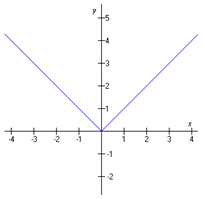
The vertex of the graph above is (0, 0). An absolute value function has some similarities to a quadratic. The functions can both be written in vertex form and their graphs are both symmetrical.
Example 1
Step 1. Determine the vertex of the equation.
The (h, k) of the equation, (3, -2), will be the vertex of the graph.
Step 2. Determine the a-value of the equation.
Since the a-value of the equation is 1, the slope of the line to the right of the vertex is +1 and the slope of the line to the left of the vertex is -1.
Step 3. Make a graph of the equation.
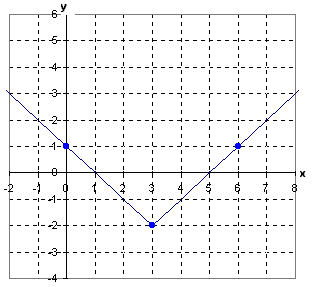
Example 2
Step 1. Determine the vertex of the equation.
The (h, k) of the equation, (0, 0), will be the vertex of the graph.
Step 2. Determine the a-value of the equation.
Since the a-value of the equation is -1, the slope of the line to the right of the vertex is -1 and the slope of the line to the left of the vertex is +1.
Step 3. Make a graph of the equation.
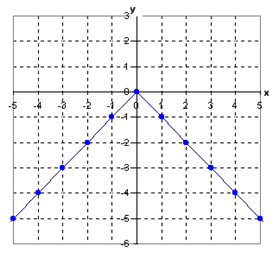
Transformations
In previous units, transformations of quadratics and other polynomials were discussed. The transformations so far follow these rules:
- f (x) + k is f(x) shifted upward k units
- f (x) - k is f(x) shifted downward k units
- f (x + h) is f(x) shifted left h units
- f (x - h) is f(x) shifted right h units
- -f(x) is f(x) flipped upside down ("reflected about the x-axis")
- f (-x) is the mirror of f(x) ("reflected about the y-axis")
- a•f(x) stretches the graph vertically if a > 1
- a•f(x) shrinks the graph vertically if 0 < a < 1
Transformations of absolute value functions follow these rules as well. For an absolute value, the function notation for the parent function is f(x) = IxI and the transformation is f(x) = a Ix - hI + k. For example, f(x) = 2 Ix - 2I +1 is graphed below along with the parent function:
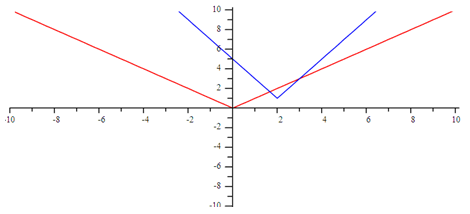
As you can see, the transformation is stretched vertically by 2, moved to the right 2 units, and up 1 unit from the parent function.
Example
Step 1. Explain the a-value.
Since a = -1, the graph is reflected across the x-axis.
Step 2. Explain the h-value.
Since h = -3, the graph will translate 3 units left.
Step 3. Explain the k-value.
Since k = -4, the graph will translate 4 units down.
Step 4. Make a graph.
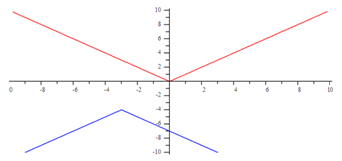
Using Calculators to Graph
Calculator instructions
Solving by Graphing
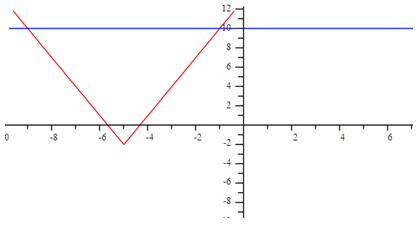
You can see by the graph that there are two solutions, where the red and blue graphs intersect. This is something absolute value functions also have in common with quadratics. In this case, the solutions are x = -1 and x = -9 which can be verified by solving algebraically.
Interactive Practice
Practice
Answer Key
Sources
Algebasics, http://www.algebasics.com/3way5.html (accessed 08/22/2010).
Coffman, Joseph. "Absolute Value Functions." http://www.jcoffman.com/Algebra2/ch2_5.htm (accessed 08/22/2010).
Embracing Mathematics, Assessment & Technology in High Schools; A Michigan Mathematics & Science Partnership Grant Project
Holt, Rinehart, & Wilson, http://my.hrw.com/math06_07/nsmedia/ lesson_videos/alg2/player.html?contentSrc=7774/7774.xml (accessed 08/22/2010).
Hot Math, "Absolute Values." http://hotmath.com/hotmath_help/ topics/absolute-value.html (accessed 08/22/2010).
Hot Math, "Practice Problems." http://hotmath.com/help/gt/genericalg1 /section_4_3.html (accessed 08/22/2010).
MathBits.com, "Absolute Values." http://mathbits.com/MathBits/ TISection/Algebra2/absolutevalue.htm (accessed 08/22/2010).
Purple Math, "Absolute Value." http://www.purplemath.com/modules/ absolute.htm (accessed 08/22/2010).
Purple Math, "Function Transformations." http://www.purplemath.com/ modules/fcntrans2.htm (accessed 08/22/2010).